The Effect of Pristine Graphene on the Mechanical Properties of Geopolymer Mortar
Abstract
1. Introduction
1.1. Nanoparticles in Geopolymer Composite
1.2. Graphene in Geopolymer Composite
2. Materials and Methods
2.1. Methodology Flow Chart
2.2. Materials
2.3. Alkali Activator Preparation
2.4. Preparation of PG Suspension in Aqueous and NaOH Solution
2.5. Preparation of PG-Reinforced Geopolymer Mortar
- The ratio of liquid activator to fly ash by mass: 0.4;
- Na2SiO3 to NaOH ratio: 2.5;
- NaOH concentration: 14 M;
- Fly-ash-to-sand ratio: 0.5;
- Superplasticiser dosage: 1% by mass of the fly ash;
- Additional water content: 7.24% by mass of the fly ash;
- Curing time: 24 h;
- Curing temperature: 75 °C;
- Rest period: 15 min.
2.6. Sequence of Mixing
2.7. Characterisation of the Materials
2.8. The Dispersion State of the Suspended PG
2.9. Fresh and Hardened Properties of Geopolymer Mortar
3. Results and Discussion
3.1. Characterisation and Dispersion of the Industrially Produced Pristine Graphene
3.2. Characterisation of the Precursor
3.3. Effect of Pristine Graphene on the Flow of Pristine Graphene-Reinforced Geopolymer Mortar
3.4. Effect of Pristine Graphene on the Mechanical Properties of Pristine Graphene-Reinforced Geopolymer Mortar
3.5. Test of Hypothesis to Evaluate the Benefit of the Different Dosages of the PG on the Geopolymer Mortar
4. Conclusions
- The dispersion of PG by ultrasonication in an aqueous solution with polycarboxylate ether superplasticiser as the surfactant was best fit for dispersion of PG, and the PG content of less than 5% of the aqueous solution resulted in good dispersion.
- The use of a large-size PG (50 µm) that was industrially manufactured was proven, for the first time, to be effective in improving the mechanical properties of the geopolymer mortar.
- Adding PG to the geopolymer mortar improved the compressive strength at 7 and 28 days and the tensile and flexural strengths at 28 days. This improvement was linked to the effect of the PG in reinforcing the mortar to prevent cracks.
- The PG content was found to significantly improve the mechanical properties of the geopolymer mortar up to 0.07% PG addition. This addition was the optimum for this application as it improves the compressive, flexural, and tensile strengths by 14.4%, 17.35%, and 25.96% at 28 days, respectively.
- The inference drawn by conducting ANOVA and Kruskal–Wallis tests revealed that the improvement of the mechanical properties could be linked to the addition of PG up to 0.07% of the precursor.
5. Recommendation for Further Research
- Future studies should consider the morphology and characterisation of the PG-reinforced GC to ascertain the interaction between the geopolymer matrix and the pristine graphene.
- The effect of the various PG sizes on the strength improvement of the geopolymer composite should be presented to clarify and underpin other underplaying factors responsible for the property improvement of geopolymer composite.
- The cost implication of using pristine graphene in the geopolymer composite should be considered to seek opportunities to commercialise the product.
- There is a potential for improved strength development if ways can be devised to increase the water content in the PG-reinforced geopolymer composite for PG contents greater than 0.07%.
Author Contributions
Funding
Institutional Review Board Statement
Informed Consent Statement
Data Availability Statement
Acknowledgments
Conflicts of Interest
References
- Nanavati, S.C.; Lulla, S.J.; Singh, A.R.; Mehta, D.B.; Patel, A.M.; Lade, A.D. A Review on Fly Ash Based Geopolymer Concrete. IOSR J. Mech. Civ. Eng. 2017, 14, 12–16. [Google Scholar] [CrossRef]
- Annapurna, D.; Kishore, R.; Ushaee, M. Comparative Study of Experimental and Analytical Results of Geo Polymer Concrete. Int. J. Civ. Eng. Technol. 2016, 7, 211–219. [Google Scholar]
- Ismail, F.I.; Farhan, S.A.; Husna, N.; Shafiq, N.; Wahab, M.M.A.; Razak, S.N.A. Influence of Graphene Nanoplatelets on the Compressive and Split Tensile Strengths of Geopolymer Concrete. IOP Conf. Ser. Earth Environ. Sci. 2021, 945, 012060. [Google Scholar] [CrossRef]
- Luhar, S.; Luhar, I. Rubberized Geopolymer Concrete: Application of Taguchi Method for Various Factors. Int. J. Recent Technol. Eng. 2020, 8, 1167–1174. [Google Scholar] [CrossRef]
- Vellaichamy, P.; Selvarajan, H.; Ramalingam, A.; Uthirasamy, K. Performance Studies on Geo Polymer Concrete. IOP Conf. Ser. Mater. Sci. Eng. 2020, 955, 012036. [Google Scholar] [CrossRef]
- Gopalakrishnan, R.; Raju, K.C. Durability of Alkali Activated Concrete—A Review. Aust. J. Basic Appl. Sci. 2015, 9, 457–464. [Google Scholar]
- Elzeadani, M.; Bompa, D.V.; Elghazouli, A.Y. Preparation and Properties of Rubberised Geopolymer Concrete: A Review. Constr. Build. Mater. 2021, 313, 125504. [Google Scholar] [CrossRef]
- Zhuang, X.Y.; Chen, L.; Komarneni, S.; Zhou, C.H.; Tong, D.S.; Yang, H.M.; Yu, W.H.; Wang, H. Fly Ash-Based Geopolymer: Clean Production, Properties and Applications. J. Clean. Prod. 2016, 125, 253–267. [Google Scholar] [CrossRef]
- Luhar, S.; Chaudhary, S.; Luhar, I. Development of Rubberized Geopolymer Concrete: Strength and Durability Studies. Constr. Build. Mater. 2019, 204, 740–753. [Google Scholar] [CrossRef]
- Aly, A.M.; El-Feky, M.S.; Kohail, M.; Nasr, E.S.A.R. Performance of Geopolymer Concrete Containing Recycled Rubber. Constr. Build. Mater. 2019, 207, 136–144. [Google Scholar] [CrossRef]
- Luhar, S.; Luhar, I.; Nicolaides, D.; Gupta, R. Durability Performance Evaluation of Rubberized Geopolymer Concrete. Sustainability 2021, 13, 5969. [Google Scholar] [CrossRef]
- Kroehong, W.; Sinsiri, T.; Jaturapitakkul, C.; Chindaprasirt, P. Effect of Palm Oil Fuel Ash Fineness on the Microstructure of Blended Cement Paste. Constr. Build. Mater. 2011, 25, 4095–4104. [Google Scholar] [CrossRef]
- Akinwumi, I.I.; Adeyeri, J.B.; Ejohwomu, O.A. Effects of Steel Slag Addition on the Plasticity, Strength and Permeability of a Lateritic Soil. In Proceedings of the Second International Conference on Sustainable Design, Engineering and Construction, ASCE, Fort Worth, TX, USA, 7–9 November 2012; pp. 457–464. [Google Scholar]
- Part, W.K.; Ramli, M.; Cheah, C.B. An Overview on the Influence of Various Factors on the Properties of Geopolymer Concrete Derived from Industrial By-Products. Constr. Build. Mater. 2015, 77, 370–395. [Google Scholar] [CrossRef]
- Krishna, R.S.; Mishra, J.; Nanda, B.; Patro, S.K.; Adetayo, A.; Qureshi, T.S. The Role of Graphene and Its Derivatives in Modifying Different Phases of Geopolymer Composites: A Review. Constr. Build. Mater. 2021, 306, 124774. [Google Scholar] [CrossRef]
- Azmi, A.A.; Abdullah, M.M.A.B.; Ghazali, C.M.R.; Sandu, A.V.; Hussin, K.; Sumarto, D.A. A Review on Fly Ash Based Geopolymer Rubberized Concrete. Key Eng. Mater. 2016, 700, 183–196. [Google Scholar] [CrossRef]
- Dong, M.; Elchalakani, M.; Karrech, A. Development of High Strength One-Part Geopolymer Mortar Using Sodium Metasilicate. Constr. Build. Mater. 2020, 236, 117611. [Google Scholar] [CrossRef]
- Longo, F.; Cascardi, A.; Lassandro, P.; Aiello, M.A. Energy and Seismic Drawbacks of Masonry: A Unified Retrofitting Solution. J. Build. Pathol. Rehabil. 2021, 6, 1–24. [Google Scholar] [CrossRef]
- Longo, F.; Cascardi, A.; Lassandro, P.; Aiello, M.A. A New Fabric Reinforced Geopolymer Mortar (FRGM) with Mechanical and Energy Benefits. Fibers 2020, 8, 49. [Google Scholar] [CrossRef]
- Zakka, W.P.; Abdul Shukor Lim, N.H.; Chau Khun, M. A Scientometric Review of Geopolymer Concrete. J. Clean. Prod. 2021, 280, 124353. [Google Scholar] [CrossRef]
- Ranjbar, N.; Mehrali, M.; Mehrali, M.; Alengaram, U.J.; Jumaat, M.Z. Graphene Nanoplatelet-Fly Ash Based Geopolymer Composites. Concr. Res. 2015, 76, 222–231. [Google Scholar] [CrossRef]
- Liu, C.; Huang, X.; Wu, Y.-Y.; Deng, X.; Liu, J.; Zheng, Z.; Hui, D. Review on the Research Progress of Cement-Based and Geopolymer Materials Modified by Graphene and Graphene Oxide. Nanotechnol. Rev. 2020, 9, 155–169. [Google Scholar] [CrossRef]
- Rafiee, M.A.; Lu, W.; Thomas, A.V.; Zandiatashbar, A.; Rafiee, J.; Tour, J.M.; Koratkar, N.A. Graphene Nanoribbon Composites. ACS Nano 2010, 4, 7415–7420. [Google Scholar] [CrossRef]
- Ho, V.D. Development of Next-Generation Construction Materials with Graphene Additives. Ph.D. Thesis, University of Adelaide, Adelaide, Australia, 2020. [Google Scholar]
- Pan, Z.; He, L.; Qiu, L.; Korayem, A.H.; Li, G.; Zhu, J.W.; Collins, F.; Li, D.; Duan, W.H.; Wang, M.C. Mechanical Properties and Microstructure of a Graphene Oxide-Cement Composite. Cem. Concr. Compos. 2015, 58, 140–147. [Google Scholar] [CrossRef]
- Ahmed, H.U.; Mohammed, A.A.; Mohammed, A.S. The Role of Nanomaterials in Geopolymer Concrete Composites: A State-of-the-Art Review. J. Build. Eng. 2022, 49, 104062. [Google Scholar] [CrossRef]
- Nuaklong, P.; Jongvivatsakul, P.; Pothisiri, T.; Sata, V.; Chindaprasirt, P. Influence of Rice Husk Ash on Mechanical Properties and Fire Resistance of Recycled Aggregate High-Calcium Fly Ash Geopolymer Concrete. J. Clean. Prod. 2020, 252, 119797. [Google Scholar] [CrossRef]
- Nuaklong, P.; Sata, V.; Wongsa, A.; Srinavin, K.; Chindaprasirt, P. Recycled Aggregate High Calcium Fly Ash Geopolymer Concrete with Inclusion of OPC and Nano-SiO2. Constr. Build. Mater. 2018, 174, 244–252. [Google Scholar] [CrossRef]
- Gao, X.; Yu, Q.L.; Brouwers, H.J.H. Characterization of Alkali Activated Slag-Fly Ash Blends Containing Nano-Silica. Constr. Build. Mater. 2015, 98, 397–406. [Google Scholar] [CrossRef]
- Duan, P.; Yan, C.; Luo, W.; Zhou, W. Effects of Adding Nano-TiO2 on Compressive Strength, Drying Shrinkage, Carbonation and Microstructure of Fluidized Bed Fly Ash Based Geopolymer Paste. Constr. Build. Mater. 2016, 106, 115–125. [Google Scholar] [CrossRef]
- da Luz, G.; Gleize, P.J.P.; Batiston, E.R.; Pelisser, F. Effect of Pristine and Functionalized Carbon Nanotubes on Microstructural, Rheological, and Mechanical Behaviors of Metakaolin-Based Geopolymer. Cem. Concr. Compos. 2019, 104, 103332. [Google Scholar] [CrossRef]
- Mustakim, S.M.; Das, S.K.; Mishra, J.; Aftab, A.; Alomayri, T.S.; Assaedi, H.S.; Kaze, C.R. Improvement in Fresh, Mechanical and Microstructural Properties of Fly Ash- Blast Furnace Slag Based Geopolymer Concrete By Addition of Nano and Micro Silica. Silicon 2021, 13, 2415–2428. [Google Scholar] [CrossRef]
- Angelin Lincy, G.; Velkennedy, R. Experimental Optimization of Metakaolin and Nanosilica Composite for Geopolymer Concrete Paver Blocks. Struct. Concr. 2021, 22, E442–E451. [Google Scholar] [CrossRef]
- Janaki, A.M.; Shafabakhsh, G.; Hassani, A. Laboratory Evaluation of Alkali-Activated Slag Concrete Pavement Containing Silica Fume and Carbon Nanotubes. Eng. J. 2021, 25, 21–31. [Google Scholar] [CrossRef]
- Yang, Z.; Li, F.; Li, W.; Chen, D.; Li, S. Effect of Carbon Nanotubes on Porosity and Mechanical Properties of Slag-Based Geopolymer. Arab. J. Sci. Eng. 2021, 46, 10731–10738. [Google Scholar] [CrossRef]
- Application, M.; Mahboubi, B.; Guo, Z.; Wu, H. Evaluation of Durability Behavior of Geopolymer Concrete Containing Nano-Silica and Nano-Clay Additives in Acidic Media. J. Civ. Eng. Mater. 2019, 2019, 157–165. [Google Scholar]
- Rabiaa, E.; Mohamed, R.A.S.; Sofi, W.H.; Tawfik, T.A. Developing Geopolymer Concrete Properties by Using Nanomaterials and Steel Fibers. Adv. Mater. Sci. Eng. 2020, 2020, 5186091. [Google Scholar] [CrossRef]
- Saini, G.; Vattipalli, U. Assessing Properties of Alkali Activated GGBS Based Self-Compacting Geopolymer Concrete Using Nano-Silica. Case Stud. Constr. Mater. 2020, 12, e00352. [Google Scholar] [CrossRef]
- Kotop, M.A.; El-Feky, M.S.; Alharbi, Y.R.; Abadel, A.A.; Binyahya, A.S. Engineering Properties of Geopolymer Concrete Incorporating Hybrid Nano-Materials. Ain Shams Eng. J. 2021, 12, 3641–3647. [Google Scholar] [CrossRef]
- Ho, V.D.; Ng, C.T.; Coghlan, C.J.; Goodwin, A.; Mc Guckin, C.; Ozbakkaloglu, T.; Losic, D. Electrochemically Produced Graphene with Ultra Large Particles Enhances Mechanical Properties of Portland Cement Mortar. Constr. Build. Mater. 2020, 234, 117403. [Google Scholar] [CrossRef]
- Geim, A.K.; Novoselov, S.K. The Rise of Graphene Nanoscience and Technology: A Collection of Reviews from Nature Journals. World Sci. 2010, 11–19. [Google Scholar]
- Zheng, Q.; Han, B.; Cui, X.; Yu, X.; Ou, J. Graphene-Engineered Cementitious Composites: Small Makes a Big Impact. Nanomater. Nanotechnol. 2017, 7, 1–18. [Google Scholar] [CrossRef]
- Tay, C.H.; Norkhairunnisa, M. Mechanical Strength of Graphene Reinforced Geopolymer Nanocomposites: A Review. Front. Mater. 2021, 8, 1–20. [Google Scholar] [CrossRef]
- Guo, S.; Qiao, X.; Zhao, T.; Wang, Y.-S. Preparation of Highly Dispersed Graphene and Its Effect on the Mechanical Properties and Microstructures of Geopolymer. J. Mater. Civ. Eng. 2020, 32, 04020327. [Google Scholar] [CrossRef]
- Liu, X.; Wu, Y.; Li, M.; Jiang, J.; Guo, L.; Wang, W.; Zhang, W.; Zhang, Z.; Duan, P. Effects of Graphene Oxide on Microstructure and Mechanical Properties of Graphene Oxide-Geopolymer Composites. Constr. Build. Mater. 2020, 247, 118544. [Google Scholar] [CrossRef]
- Sai Sunil, S.; Kolli, R. Experimental Investigation on Mechanical Properties of Fly Ash-GGBFS Based GO-Geopolymer Concrete Using Mineral Sand (Quartz-Feldspar) as Fine Aggregate. Mater. Today Proc. 2022, 60, 40–45. [Google Scholar] [CrossRef]
- Bellum, R.R.; Muniraj, K.; Indukuri, C.S.R.; Madduru, S.R.C. Investigation on Performance Enhancement of Fly Ash-GGBFS Based Graphene Geopolymer Concrete. J. Build. Eng. 2020, 32, 101659. [Google Scholar] [CrossRef]
- Maglad, A.M.; Zaid, O.; Arbili, M.M.; Ascensão, G.; Șerbănoiu, A.A.; Grădinaru, C.M.; García, R.M.; Qaidi, S.M.A.; Althoey, F.; de Prado-Gil, J. A Study on the Properties of Geopolymer Concrete Modified with Nano Graphene Oxide. Buildings 2022, 12, 1066. [Google Scholar] [CrossRef]
- Gong, K.; Pan, Z.; Korayem, A.H.; Qiu, L.; Li, D.; Collins, F.; Wang, C.M.; Duan, W.H. Reinforcing Effects of Graphene Oxide on Portland Cement Paste. J. Mater. Civ. Eng. 2015, 27, 1–6. [Google Scholar] [CrossRef]
- Shams, S.S.; Zhang, R.; Zhu, J. Graphene Synthesis: A Review. Mater. Sci. Pol. 2015, 33, 566–578. [Google Scholar] [CrossRef]
- Liu, W.-W.; Aziz, A. Review on the Effect of Electromechanical Exfoliation Parameters on the Yield of Graphene Oxide. ACS Omega 2022, 7, 33719–33731. [Google Scholar] [CrossRef] [PubMed]
- Pei, S.; Wei, Q.; Huang, K.; Cheng, H.M.; Ren, W. Green Synthesis of Graphene Oxide by Seconds Timescale Water Electrolytic Oxidation. Nat. Commun. 2018, 9, 1–9. [Google Scholar] [CrossRef]
- Pei, S.; Cheng, H.M. The Reduction of Graphene Oxide. Carbon N. Y. 2012, 50, 3210–3228. [Google Scholar] [CrossRef]
- Sajjad, U.; Sheikh, M.N.; Hadi, M.N.S. Experimental Study of the Effect of Graphene on Properties of Ambient-Cured Slag and Fly Ash-Based Geopolymer Paste and Mortar. Constr. Build. Mater. 2021, 313, 125403. [Google Scholar] [CrossRef]
- Li, Z.; Sheikh, M.N.; Feng, H.; Hadi, M.N.S. Mechanical Properties of Engineered Geopolymer Composite with Graphene Nanoplatelet. Ceram. Int. 2022, 48, 34915–34930. [Google Scholar] [CrossRef]
- Shamsaei, E.; de Souza, F.B.; Yao, X.; Benhelal, E.; Akbari, A.; Duan, W. Graphene-Based Nanosheets for Stronger and More Durable Concrete: A Review. Constr. Build. Mater. 2018, 183, 642–660. [Google Scholar] [CrossRef]
- Zhang, Y.Y.; Gu, Y.T. Mechanical Properties of Graphene: Effects of Layer Number, Temperature and Isotope. Comput. Mater. Sci. 2013, 71, 197–200. [Google Scholar] [CrossRef]
- Parviz, D.; Irin, F.; Shah, S.A.; Das, S.; Sweeney, C.B.; Green, M.J. Challenges in Liquid-Phase Exfoliation, Processing, and Assembly of Pristine Graphene. Adv. Mater. 2016, 28, 8796–8818. [Google Scholar] [CrossRef]
- Liang, W.; Zhang, G. Effect of Reduced Graphene Oxide on the Early-Age Mechanical Properties of Geopolymer Cement. Mater. Lett. 2020, 276, 128223. [Google Scholar] [CrossRef]
- Liu, J.; Fu, J.; Yang, Y.; Gu, C. Study on Dispersion, Mechanical and Microstructure Properties of Cement Paste Incorporating Graphene Sheets. Constr. Build. Mater. 2019, 199, 1–11. [Google Scholar] [CrossRef]
- Sharma, S.; Kothiyal, N.C. Influence of Graphene Oxide as Dispersed Phase in Cement Mortar Matrix in Defining the Crystal Patterns of Cement Hydrates and Its Effect on Mechanical, Microstructural and Crystallization Properties. RSC Adv. 2015, 5, 52642–52657. [Google Scholar] [CrossRef]
- Ho, V.D.; Ng, C.T.; Ozbakkaloglu, T.; Goodwin, A.; McGuckin, C.; Karunagaran, R.U.; Losic, D. Influence of Pristine Graphene Particle Sizes on Physicochemical, Microstructural and Mechanical Properties of Portland Cement Mortars. Constr. Build. Mater. 2020, 264, 120188. [Google Scholar] [CrossRef]
- ASTM-C618; Standard Specification for Coal Fly Ash and Raw or Calcined Natural Pozzolan for Use as a Mineral Admixture in Concrete in Concrete. ASTM International: West Conshohocken, PA, USA, 1999.
- Ryu, G.S.; Lee, Y.B.; Koh, K.T.; Chung, Y.S. The Mechanical Properties of Fly Ash-Based Geopolymer Concrete with Alkaline Activators. Constr. Build. Mater. 2013, 47, 409–418. [Google Scholar] [CrossRef]
- ASTM-C33; Standard Specification for Concrete Aggregates. ASTM International: West Conshohocken, PA, USA, 2016.
- Somna, K.; Jaturapitakkul, C.; Kajitvichyanukul, P.; Chindaprasirt, P. NaOH Activated Ground Fly Ash Geopolymer Cured at Ambient Temperature. Fuel 2011, 90, 2118–2124. [Google Scholar] [CrossRef]
- Pavithra, P.; Srinivasula Reddy, M.; Dinakar, P.; Hanumantha Rao, B.; Satpathy, B.K.; Mohanty, A.N. A Mix Design Procedure for Geopolymer Concrete with Fly Ash. J. Clean. Prod. 2016, 133, 117–125. [Google Scholar] [CrossRef]
- Ho, V.D.; Ng, C.T.; Ozbakkaloglu, T.; Karunagaran, R.U.; Farivar, F.; Goodwin, A.; Guckin, C.M.; Ho, V.D.; Losic, D. Investigating the Reinforcing Mechanism and Optimised Dosage of Pristine Graphene for Enhancing Mechanical Strengths of Cementitious Composites. RSC Adv. 2020, 10, 42777–42789. [Google Scholar] [CrossRef] [PubMed]
- ASTM-D422-63; Standard Test Method for Particle-Size Analysis of Soils. ASTM International: West Conshohocken, PA, USA, 2007.
- ASTM-C1437; Standard, Test Method for Flow of Hydraulic Cement Mortar. ASTM International: West Conshohocken, PA, USA, 2015.
- ASTM-C109/C109M-08; Standard, Test Method for Compressive Strength of Hydraulic Cement Mortars. ASTM International: West Conshohocken, PA, USA, 2008.
- ASTM-C307-03; Standard, Test Method for Tensile Strength of Chemical- Resistant Mortar, Grouts, and Monolithic Surfacings Monolithic Surfacings. ASTM International: West Conshohocken, PA, USA, 2012.
- ASTM-C348-08; Standard Test Method for Flexural Strength of Hydraulic-Cement Mortars. ASTM International: West Conshohocken, PA, USA, 2009.
- Abdul Latif Rajab Al Balushi, D.; Devi, G.; Jabr Ahmed, S.; Said Almawali, N. Synthesis and Application of Nano and Micro-Silica Particles to Enhance the Mechanical Proprieties of Cement Concrete. Concr. Res. Lett. 2016, 7, 113–122. [Google Scholar]
- Arita, S.; Aoyagi, N.; Ohshita, K.; Tsubota, Y.; Ogihara, T. Synthesis and Characterization of Spherical Alumina Nanoparticles by Spray Pyrolysis Using Radiofrequency Plasma. J. Ceram. Soc. Jpn. 2017, 125, 539–542. [Google Scholar] [CrossRef]
- Zhao, L.; Zhu, S.; Wu, H.; Zhang, X.; Tao, Q.; Song, L.; Song, Y.; Guo, X. Deep Research about the Mechanisms of Graphene Oxide (GO) Aggregation in Alkaline Cement Pore Solution. Constr. Build. Mater. 2020, 247, 118446. [Google Scholar] [CrossRef]
- Monzo, J.; Paya, J.; Peris-Mora, E. A Preliminary Study of Fly Ash Granulometric Influence on Mortar Strength. Cem. Concr. Res. 1994, 24, 791–796. [Google Scholar] [CrossRef]
- Sevim, Ö.; Demir, İ. Optimisation of Fly Ash Particle Size Distribution for Cementitious Systems with High Compactness. Constr. Build. Mater. 2019, 195, 104–114. [Google Scholar] [CrossRef]
- Shahrajabian, F.; Behfarnia, K. The Effects of Nano Particles on Freeze and Thaw Resistance of Alkali-Activated Slag Concrete. Constr. Build. Mater. 2018, 176, 172–178. [Google Scholar] [CrossRef]
- Kjaernsmo, H.; Kakay, S.; Fossa, K.T.; Gronli, J. The Effect of Graphene Oxide on Cement Mortar. IOP Conf. Ser. Mater. Sci. Eng. 2018, 362, 012012. [Google Scholar] [CrossRef]
- Ibrahim, M.; Rahman, M.K.; Johari, M.A.M.; Maslehuddin, M. Effect of Incorporating Nano-Silica on the Strength of Natural Pozzolan-Based Alkali-Activated Concrete. In International Congress on Polymers in Concrete; Springer: Berlin/Heidelberg, Germany, 2018; pp. 703–709. [Google Scholar]
- Zhang, G.; Lu, J. Experimental Research on the Mechanical Properties of Graphene Geopolymer. AIP Adv. 2018, 8, 065209. [Google Scholar] [CrossRef]
- Gholampour, A.; Kiamahalleh, M.V.; Tran, D.N.H.; Ozbakkaloglu, T.; Losic, D. Revealing the Dependence of the Physiochemical and Mechanical Properties of Cement Composites on Graphene Oxide Concentration. RSC Adv. 2017, 7, 55148–55156. [Google Scholar] [CrossRef]
- Wang, B.; Pan, B. Subset-Based Local vs. Finite Element-Based Global Digital Image Correlation: A Comparison Study. Theor. Appl. Mech. Lett. 2016, 6, 200–208. [Google Scholar] [CrossRef]

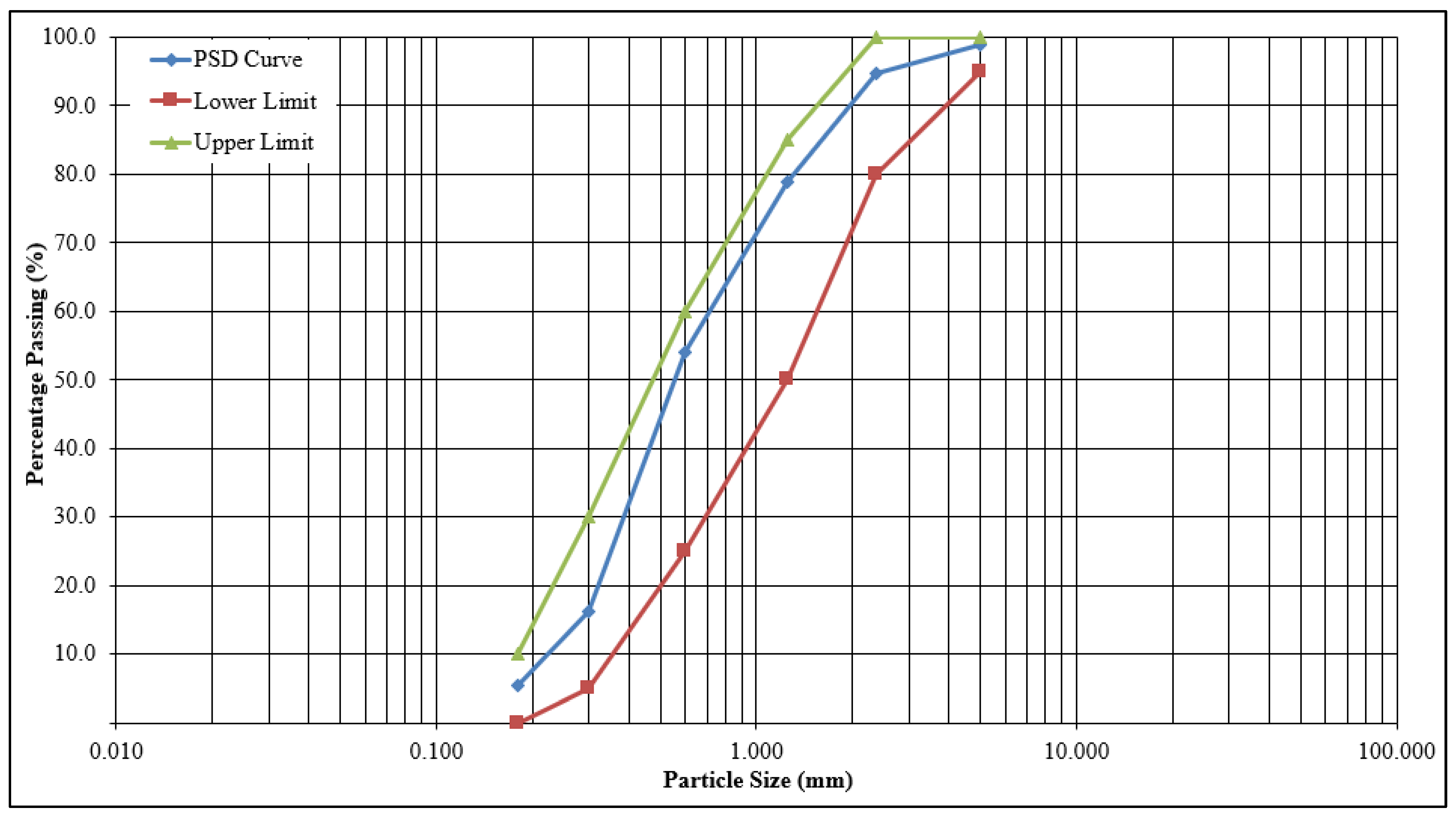

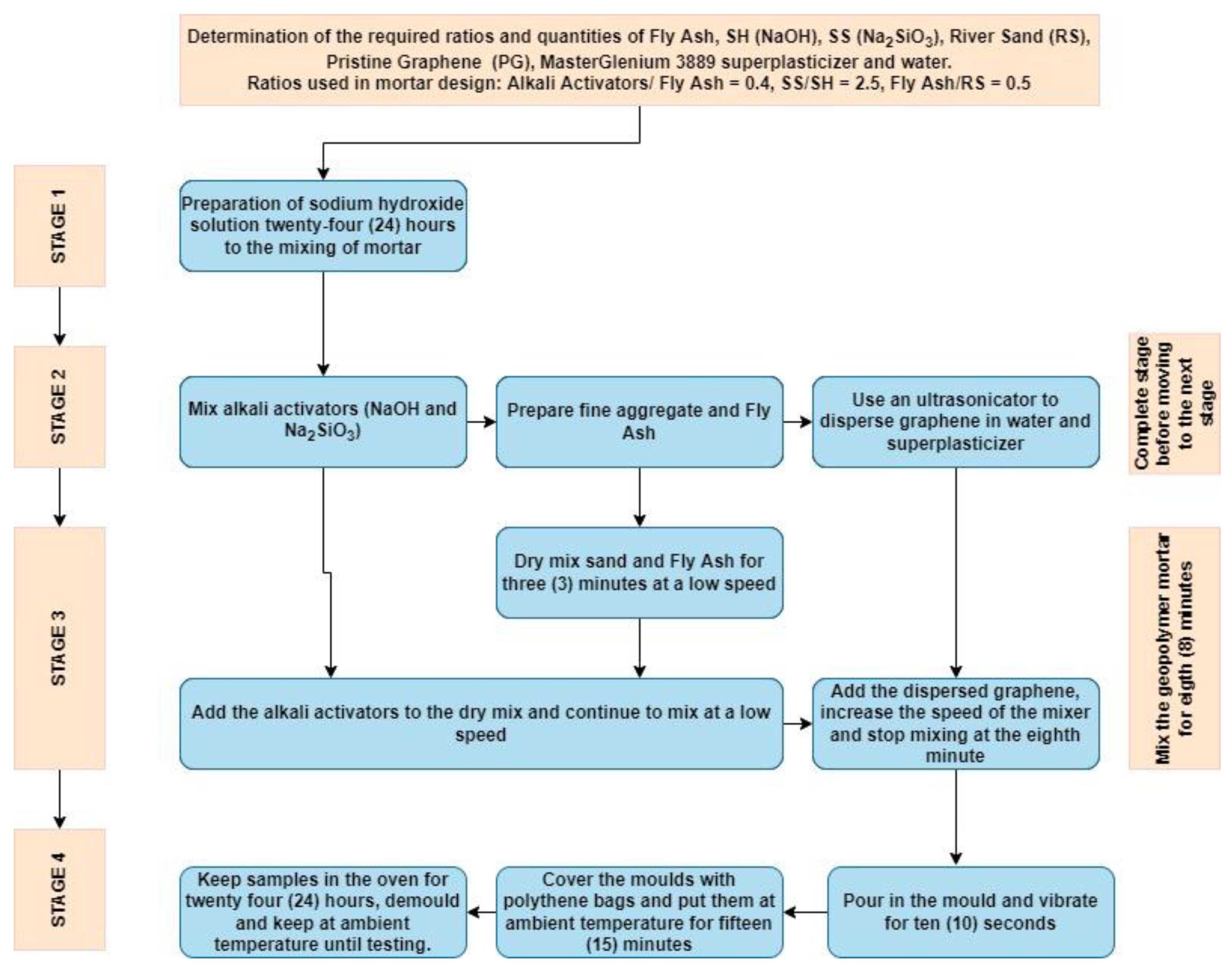
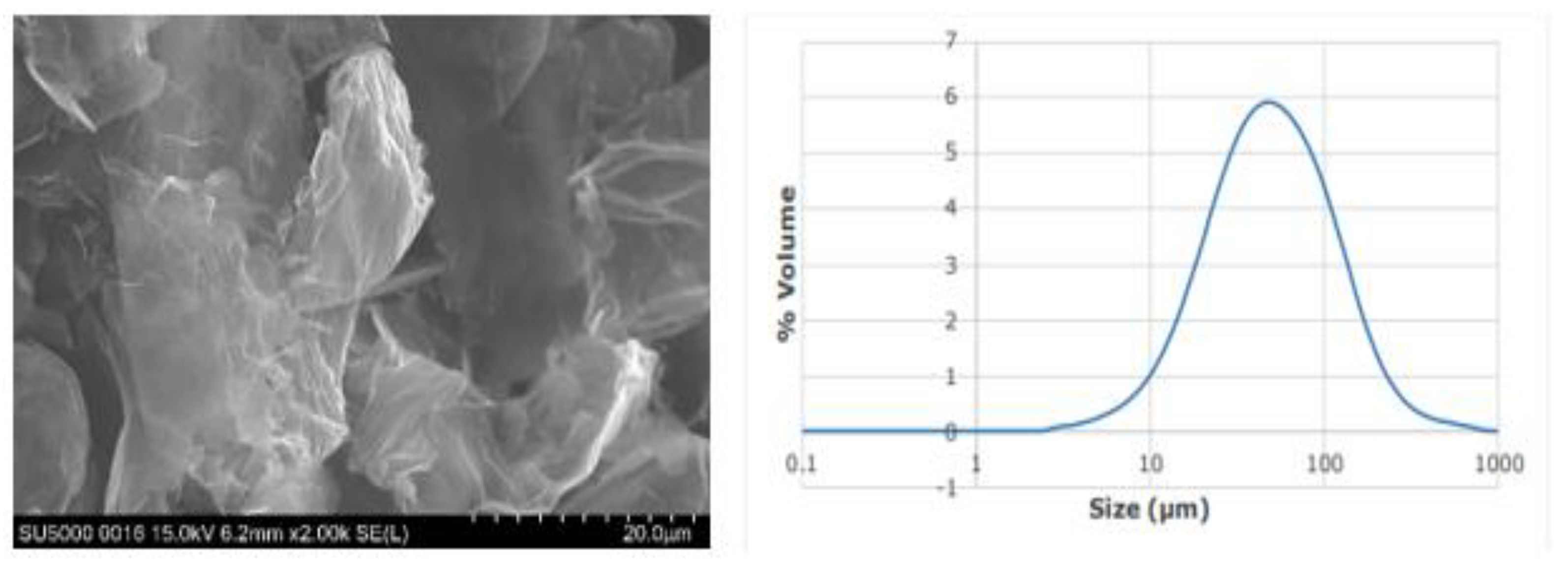
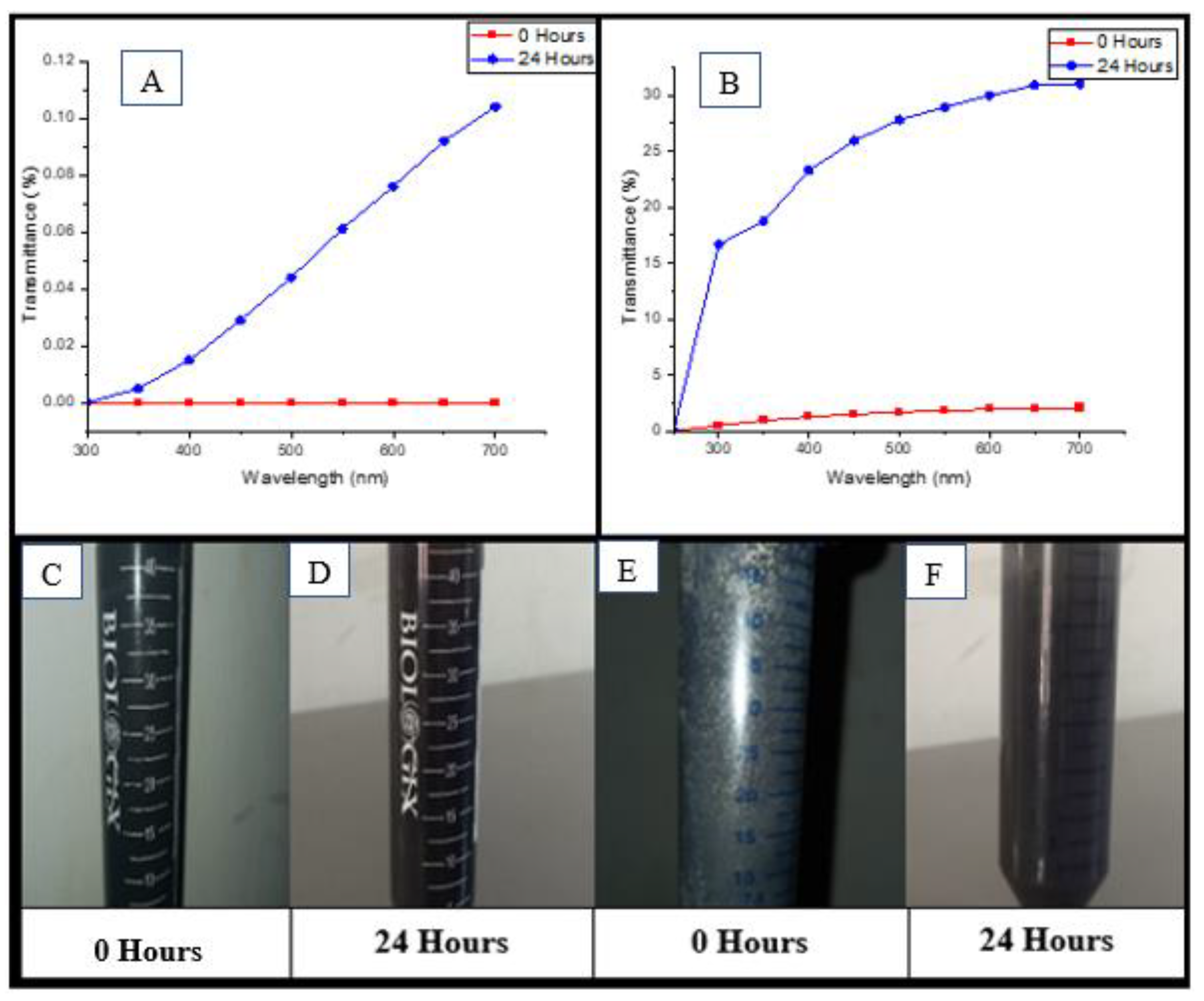
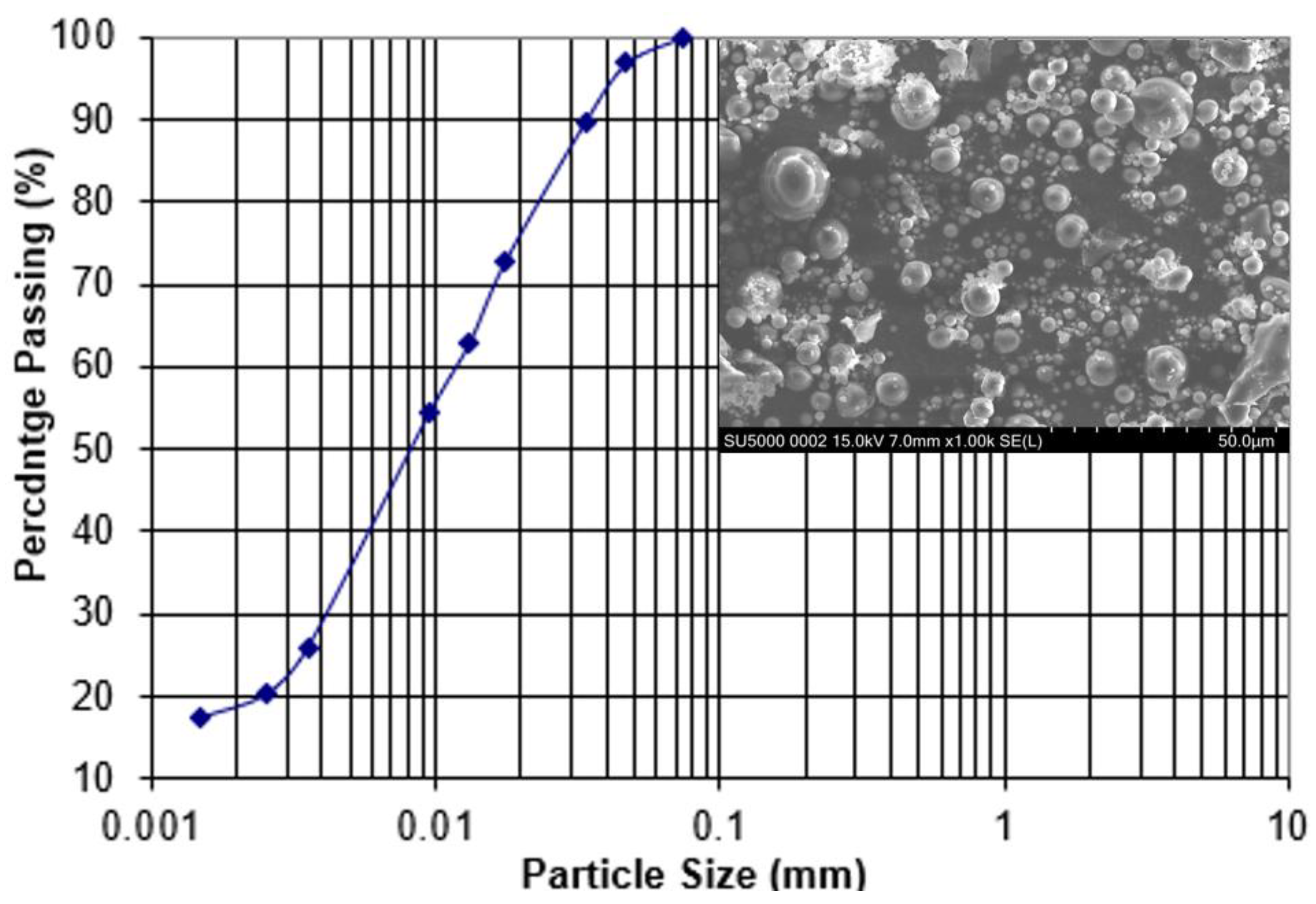
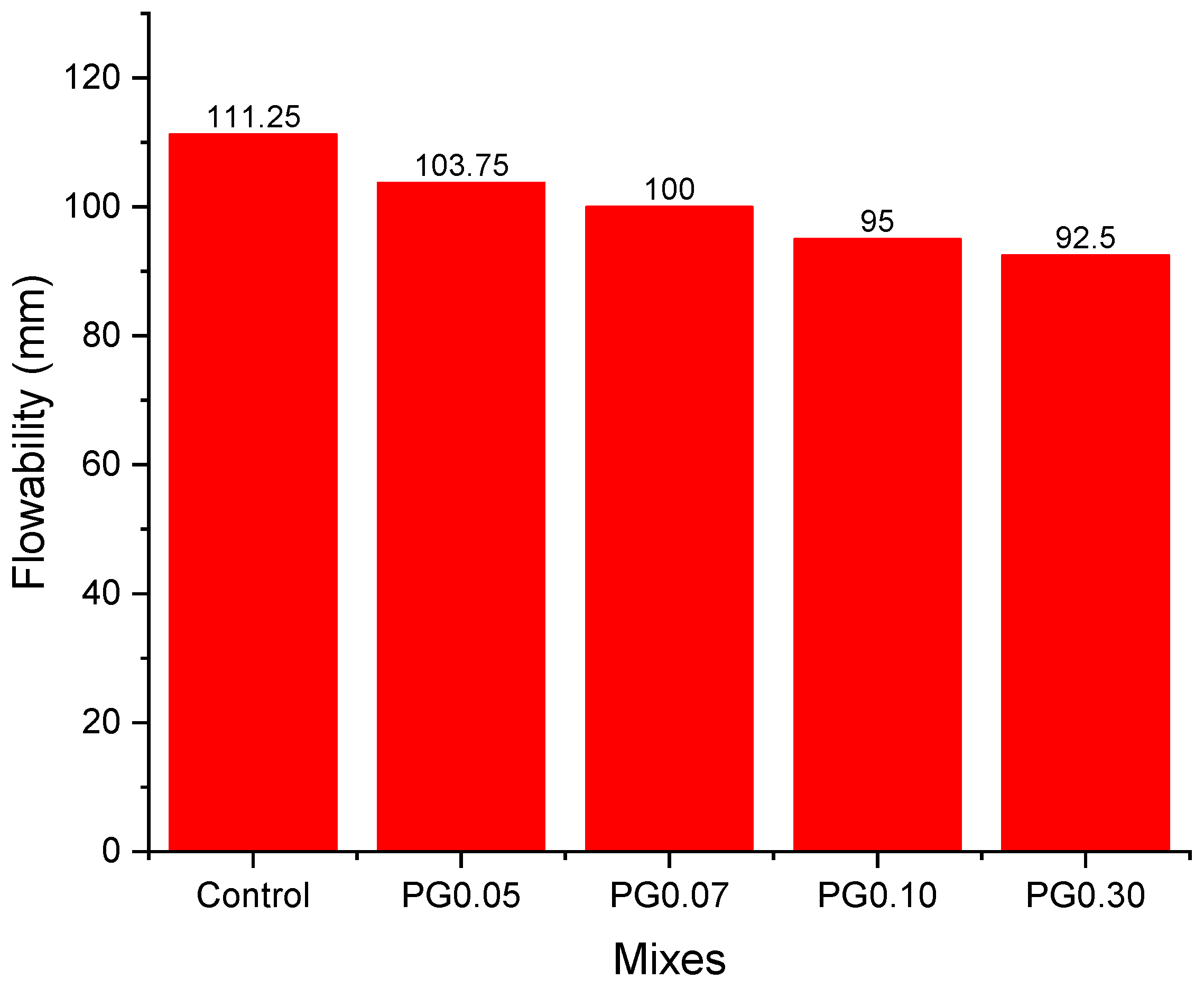
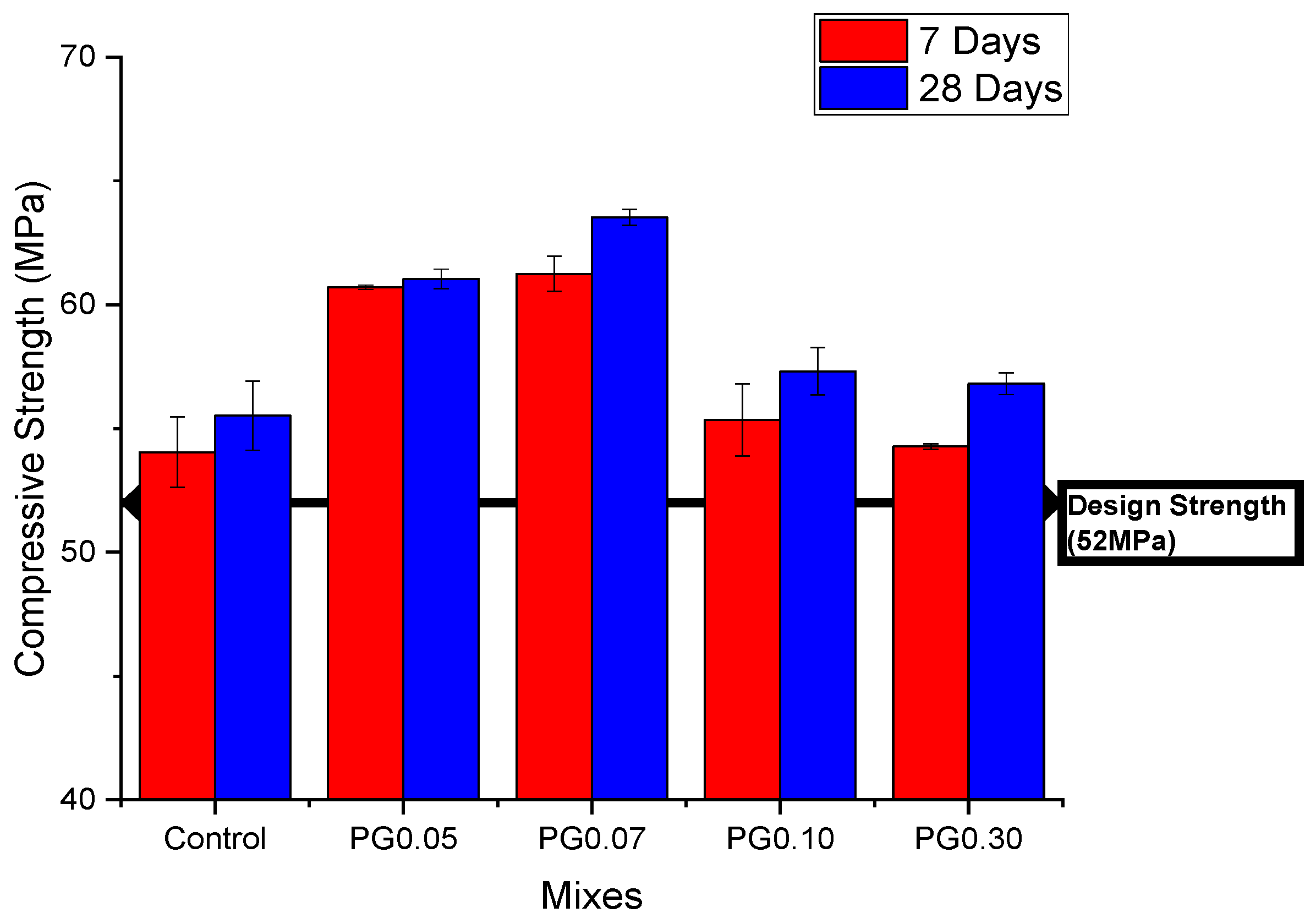
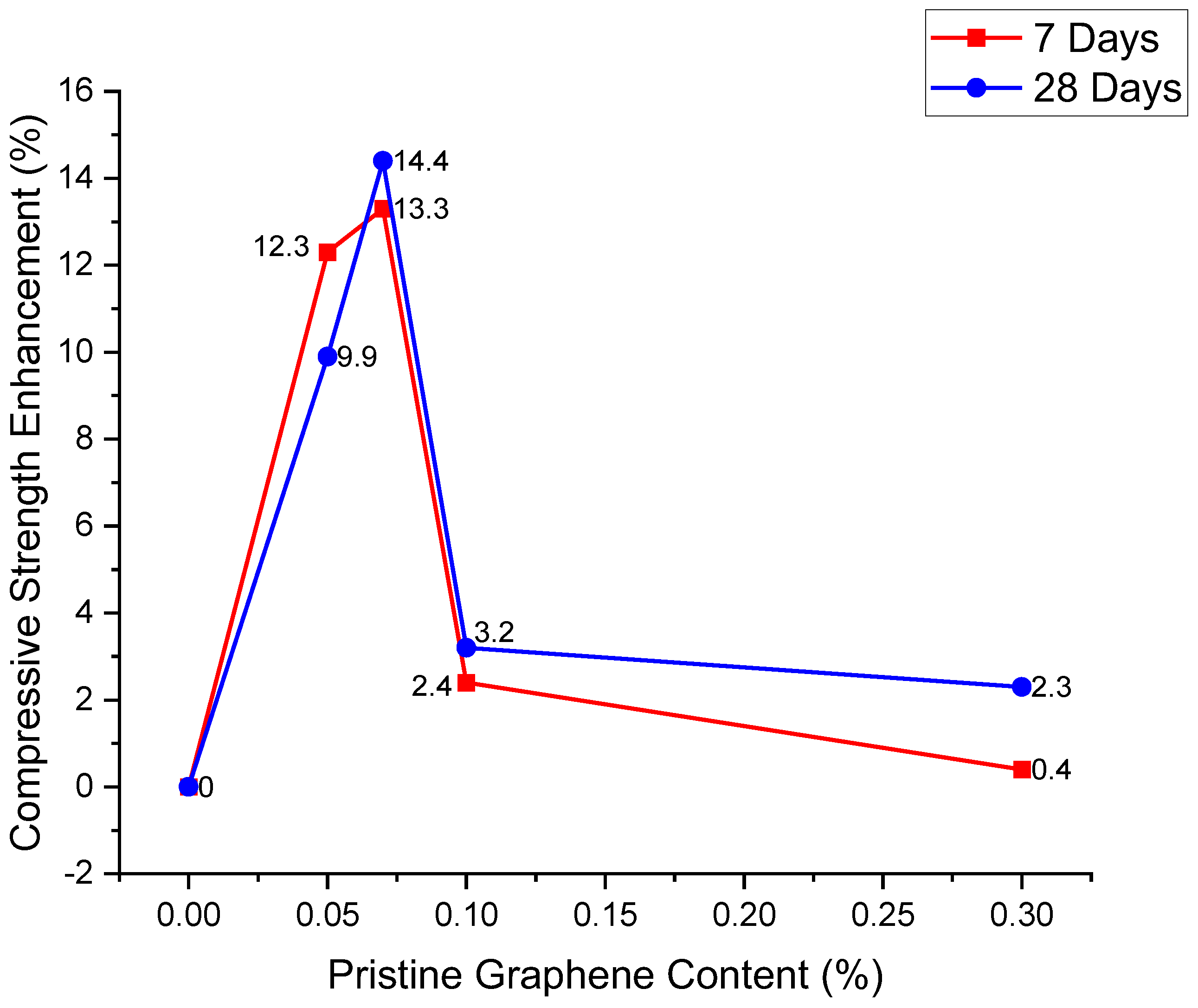
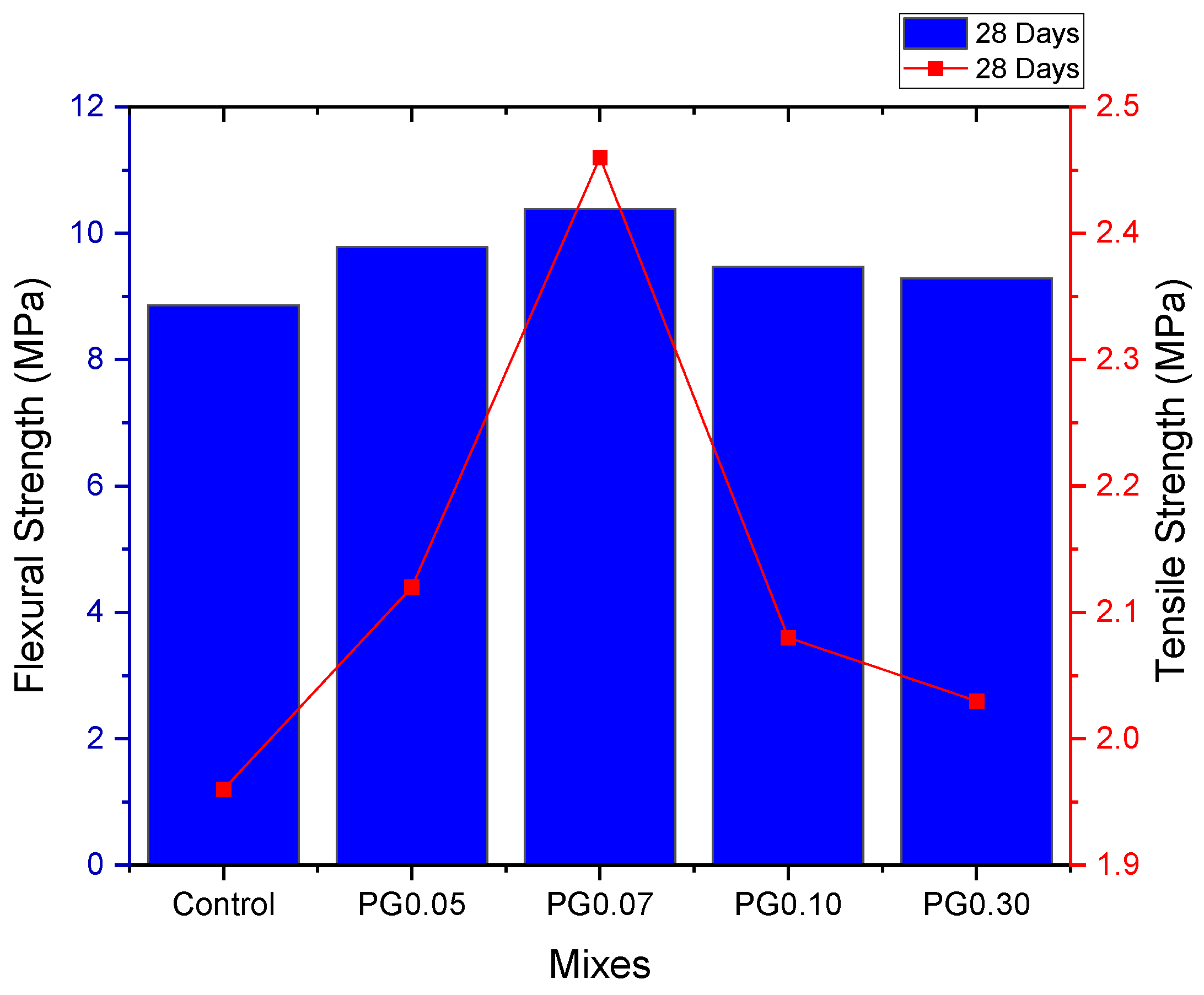


| Element Name | Composition | Specifications of ASTM C618 for Class F Fly Ash |
|---|---|---|
| Chemical Analysis | ||
| Silicon Dioxide (SiO2) | 55.865% | |
| Aluminium Oxide (Al2O3) | 22.657% | |
| Iron Oxide (Fe2O3) | 6.118% | |
| Addition of SiO2, Al2O3, and Fe203 | 84.640% | Min (70%) |
| Calcium Oxide | 6.501% | Max (10%) |
| Magnesium Oxide (MgO) | 5.194% | |
| Sulphur Trioxide (SO3) | 0.358% | Max (5%) |
| Loss on Ignition | 1.750% | Max (6%) |
| Physical Analysis | ||
| Specific Gravity | 2.500 | |
| Amount Retained on 45 Microns Sieve (Fineness) | 4.000% | Max (34%) |
| Moisture Content | 0.952% | Max (3%) |
| pH | Chlorine Content (%) | Specific Gravity at 25 °C (Kg/dm3) | Appearance |
|---|---|---|---|
| 5–7 | 0% | 1.073 | Whitish to light brown clear to cloudy liquid |
| Name | Average Particle Size (µm) | Thickness (Layers) | Purity (%) | Bulk Density (g cm−3) | Percentage of Solid (%) |
|---|---|---|---|---|---|
| PG-50 | 50 | 5–10 | 99 | 1.13 | 23.27 |
| Compound | Total Solids (%) | Specific Gravity @20 °C | Na2O (%) | SiO2 (%) | Na2O: SiO2 | Purity (%) |
|---|---|---|---|---|---|---|
| NaOH | 41.70 | 1.34 | - | - | - | >98 |
| Na2SiO3 | 43.62 | 1.53 | 14.07 | 29.55 | 0.4762 | - |
| Label | PG Content (%) | Fly Ash (Kg/M3) | Sand (Kg/M3) | LA (Kg/M3) | NaOH (Kg/M3) | Na2SiO3 (Kg/M3) | PG (Kg/M3) | SP (Kg/M3) | Water (Kg/M3) |
|---|---|---|---|---|---|---|---|---|---|
| PG0 | 0 | 647.89 | 1295.78 | 259.16 | 74.04 | 185.11 | 0.00 | 6.48 | 46.91 |
| PG0.05 | 0.05 | 647.89 | 1295.78 | 259.16 | 74.04 | 185.11 | 0.32 | 6.48 | 46.91 |
| PG0.07 | 0.07 | 647.89 | 1295.78 | 259.16 | 74.04 | 185.11 | 0.45 | 6.48 | 46.91 |
| PG0.10 | 0.10 | 647.89 | 1295.78 | 259.16 | 74.04 | 185.11 | 0.65 | 6.48 | 46.91 |
| PG0.30 | 0.30 | 647.89 | 1295.78 | 259.16 | 74.04 | 185.11 | 1.94 | 6.48 | 46.91 |
| PG0.50 | 0.50 | 647.89 | 1295.78 | 259.16 | 74.04 | 185.11 | 3.24 | 6.48 | 46.91 |
| PG1.00 | 1.00 | 647.89 | 1295.78 | 259.16 | 74.04 | 185.11 | 6.48 | 6.48 | 46.91 |
| 7 Days | 28 Days | |||
|---|---|---|---|---|
| Difference of Levels | Mean Difference | Significance Level | Mean Difference | Significant Level |
| PG0.05—Control | 6.6567 | 0.001 | 5.5203 | 0.001 |
| PG0.07—Control | 7.1970 | 0.001 | 8.0077 | 0.000 |
| PG0.1—Control | 1.2983 | 0.409 | 1.7907 | 0.197 |
| PG0.3—Control | 0.2260 | 0.743 | 1.2867 | 0.340 |
| 28 Days Flexural Strength | 28 Days Tensile Strength | |||
|---|---|---|---|---|
| Difference of Levels | Mean Difference | Significance Level | Mean Difference | Significance Level |
| Control—PG0.05 | 0.9287 | 0.005 | −7.333 | 0.044 |
| Control—PG0.07 | 1.5360 | 0.000 | −10.333 | 0.004 |
| Control—PG0.1 | 0.6093 | 0.047 | −3.667 | 0.313 |
| Control—PG0.3 | 0.4360 | 0.140 | −0.333 | 0.927 |
Disclaimer/Publisher’s Note: The statements, opinions and data contained in all publications are solely those of the individual author(s) and contributor(s) and not of MDPI and/or the editor(s). MDPI and/or the editor(s) disclaim responsibility for any injury to people or property resulting from any ideas, methods, instructions or products referred to in the content. |
© 2023 by the authors. Licensee MDPI, Basel, Switzerland. This article is an open access article distributed under the terms and conditions of the Creative Commons Attribution (CC BY) license (https://creativecommons.org/licenses/by/4.0/).
Share and Cite
Abiodun, O.; Kabubo, C.; Mutuku, R.; Ejohwomu, O. The Effect of Pristine Graphene on the Mechanical Properties of Geopolymer Mortar. Sustainability 2023, 15, 1706. https://doi.org/10.3390/su15021706
Abiodun O, Kabubo C, Mutuku R, Ejohwomu O. The Effect of Pristine Graphene on the Mechanical Properties of Geopolymer Mortar. Sustainability. 2023; 15(2):1706. https://doi.org/10.3390/su15021706
Chicago/Turabian StyleAbiodun, Oluwapelumi, Charles Kabubo, Raphael Mutuku, and Obuks Ejohwomu. 2023. "The Effect of Pristine Graphene on the Mechanical Properties of Geopolymer Mortar" Sustainability 15, no. 2: 1706. https://doi.org/10.3390/su15021706
APA StyleAbiodun, O., Kabubo, C., Mutuku, R., & Ejohwomu, O. (2023). The Effect of Pristine Graphene on the Mechanical Properties of Geopolymer Mortar. Sustainability, 15(2), 1706. https://doi.org/10.3390/su15021706








